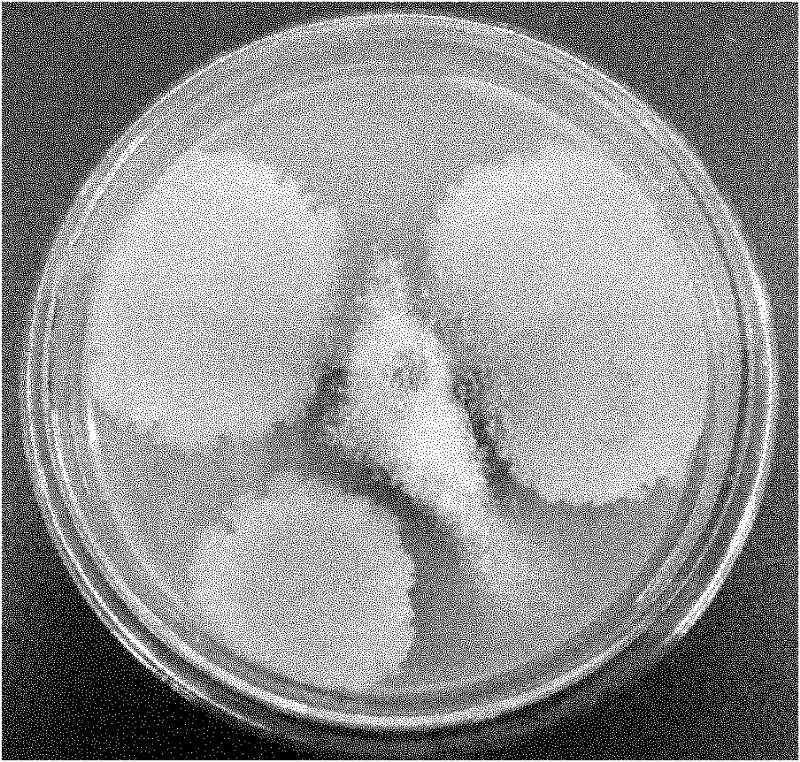Endophytic antagonistic strain for controlling soft rot of camellia oleifera and application thereof
A technology of soft rot and bacterial strains, which is applied to Bacillus amyloliquefaciens L46, which is highly effective in preventing and controlling soft rot of camellia oleifera, and its application fields, can solve the problems of weak or even blank technology, and no biological pesticides for preventing and treating soft rot of camellia oleifera, and achieve good development The effect of application prospect, easy industrial production, and simple cultivation conditions
- Summary
- Abstract
- Description
- Claims
- Application Information
AI Technical Summary
Problems solved by technology
Method used
Image
Examples
Embodiment 1
[0026] The separation of embodiment 1 bacillus amyloliquefaciens L46
[0027] The healthy leaves of common camellia oleifera are taken, separated, purified and preserved by conventional methods.
[0028] After the camellia oleifera was rinsed with water, an appropriate amount of healthy tissue was selected, weighed separately, cut into 5mm×5mm tissue pieces, soaked in 75% ethanol for 1min, then soaked in 0.1% mercuric solution for 40s-70s, and then placed Soak in 75% ethanol for 30s, take it out and rinse it with sterile water 4 times. Add 10ml of sterile water and a little sterilized quartz sand into a sterile mortar to grind into a homogenate, cover and let stand for 30 minutes, serially dilute the homogenate 10 times, and pipette 0.1ml to prepare After smearing evenly on a good NA plate, put it into an incubator for cultivation, record the amount of bacteria after 48 hours, and select according to the shape, color and size of the colony, purify and store on the plate, and ...
Embodiment 2
[0029] The screening of embodiment 2 bacillus amyloliquefaciens L46
[0030] Preliminary screening: use the confrontation culture method. Screening of endophyte antagonistic pathogenic fungi. Put the 6mm-diameter oleiferia soft rot bacterial cake in the center of the plate, and then use the inoculation ring to pick up the suspension of the bacteria to be tested and pick up 2 to 3 kinds of endophytic bacteria equidistantly (3cm from the center of the plate). Incubate in the dark at 25°C in an incubator, observe and record the presence and size of the bacteriostatic zone after 4 days, and repeat 3 times in total. Select 10 strains with a bacteriostatic zone width greater than or equal to 4mm for re-screening, followed by L1, L6, L12, L19, L29, L33, L35, L39, L46, L48, and re-screen (see Table 1).
[0031] Table 1 Antibacterial effect of endophytic bacteria on Camellia oleifera soft rot
[0032]
[0033] Re-screening: use fermentation method. After the 10 initially screene...
Embodiment 3
[0036] Example 3 The inhibitory effect of Bacillus amyloliquefaciens L46 on the hyphae of camellia oleifera soft rot
[0037] Put the Camellia oleifera soft rot bacterial cake with a diameter of 6mm in the center of the PDA plate of the potato sucrose medium, and then inoculate the antagonistic bacteria L46 at an equal distance of 3cm, repeat three times, culture at 25-28°C, and measure the diameter of the inhibition zone after 4 days. Depend on image 3 It can be seen that Bacillus amyloin L46 has a strong antibacterial effect on Camellia oleifera soft rot.
PUM
 Login to View More
Login to View More Abstract
Description
Claims
Application Information
 Login to View More
Login to View More - R&D
- Intellectual Property
- Life Sciences
- Materials
- Tech Scout
- Unparalleled Data Quality
- Higher Quality Content
- 60% Fewer Hallucinations
Browse by: Latest US Patents, China's latest patents, Technical Efficacy Thesaurus, Application Domain, Technology Topic, Popular Technical Reports.
© 2025 PatSnap. All rights reserved.Legal|Privacy policy|Modern Slavery Act Transparency Statement|Sitemap|About US| Contact US: help@patsnap.com



